Microsoft Teams Integration Guide | PagerDuty
Microsoft Teams + PagerDuty Integration Benefits
- Reduce downtime and streamline incident remediation by adding PagerDuty’s incident management functionality to Microsoft Teams' collaboration tools.
- Send PagerDuty incident notifications with critical details to team channel members.
- Team channel members will be able to view and create incidents. They can acknowledge, resolve and perform other actions within Microsoft Teams.
Requirements
A PagerDuty Admin is required to authorize the connection of PagerDuty to Microsoft Teams. If you do not have this role, please reach out to a PagerDuty Admin or Account Owner within your organization to configure the integration. For more information about these PagerDuty user roles, please read our Advanced Permissions guide.
A Microsoft Teams Admin must enable third-party apps for your organization, in order to download the PagerDuty app.
A Microsoft Admin will need to authorize the Microsoft Graph API permissions required by the PagerDuty app.
Private & Shared Channels
Please note that the PagerDuty application cannot currently be integrated with private or shared channels in Microsoft Teams.
We do support the creation of private Microsoft Teams chats for an incident, using our Teams actions in Incident Workflows.
How it Works
- PagerDuty’s Microsoft Teams application installs into a team and can be configured for one or more of the team’s channels.
- A PagerDuty service uses webhooks to send information about an incident to a Pagerduty-developed Microsoft Teams service. This service receives the webhook from PagerDuty, composes a message, and sends to team channels via Microsoft’s Bot Kit Framework. Any subsequent changes to the PagerDuty incident will update on progress within the channel, and additional incident details can be viewed from the Microsoft Teams notification card.
- Read more about how authentication with Microsoft Teams works.
Version
This guide is for our latest Microsoft Teams integration, version 1.2.0.
Looking for a Different Version?
The legacy Microsoft Teams integration guide is also available for those who have previously installed and are still using that version. The legacy Microsoft Teams application is no longer available for initial installation from the Microsoft store. For customers using the legacy application, Microsoft has kept all configurations and will continue to support the integration for these customers.
If you would like to upgrade your application from the legacy to the most current version, please follow our Upgrade Instructions
Integration Walkthrough
Connect PagerDuty to a Microsoft Team
Note: These steps are only necessary upon initial app installation to a Microsoft Team. If the PagerDuty app is already installed to your team, you can proceed with linking PagerDuty services to your team’s channels .
- From the Microsoft Teams Marketplace app store, search and click the PagerDuty app. If your PagerDuty account is hosted in the EU service region, click the PagerDuty EU app.
- Click Add to a Team and select a Team or Channel for initial installation. The app will be installed to standard channels within the selected team.

PagerDuty installation
-
Click Set up a bot to install the app.
After the installation, you will receive a message in a private chat with the PagerDuty bot, confirming that the installation is complete.
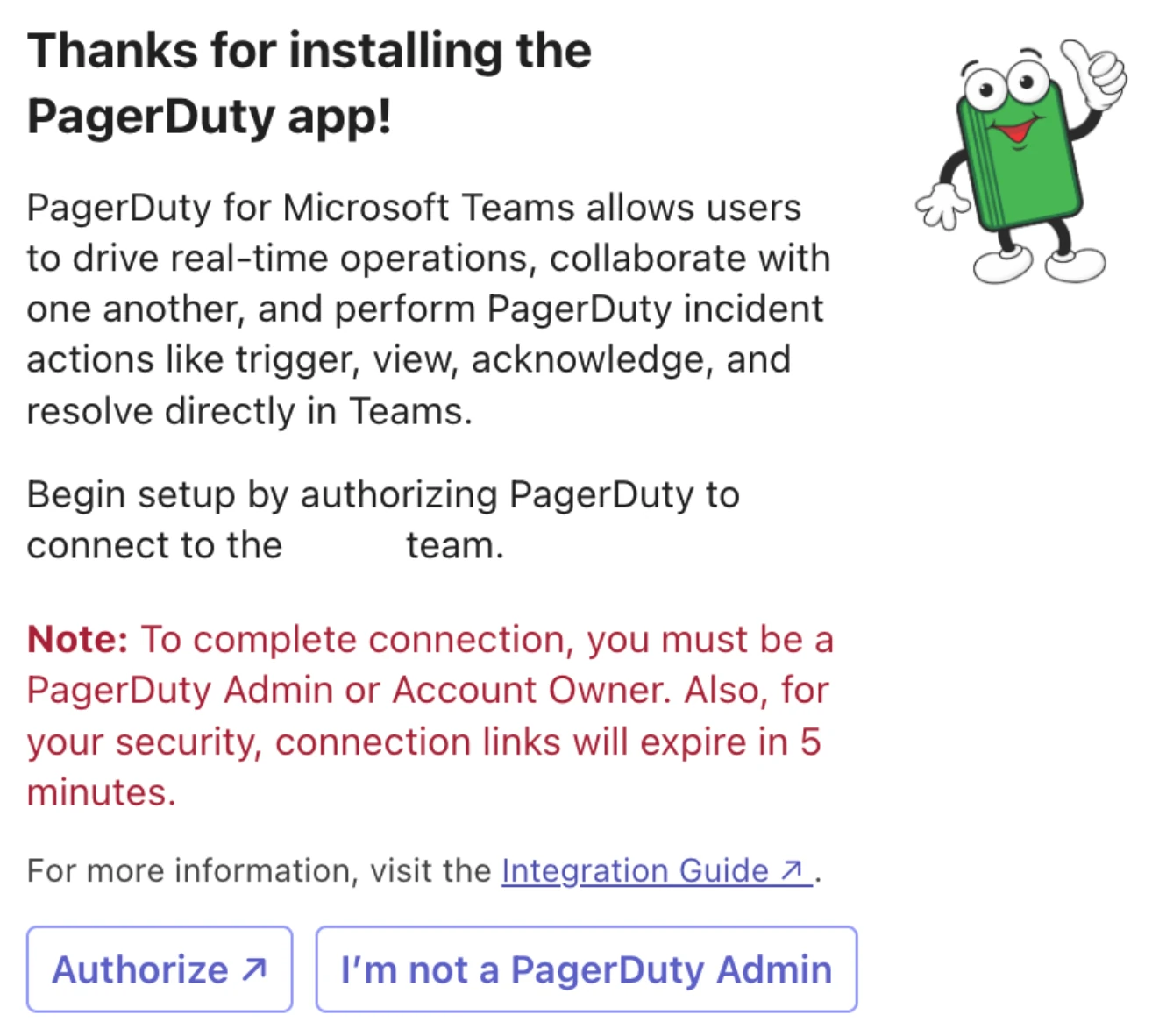
PagerDuty Private Chat Prompt to Authorize the App
Note: The PagerDuty app's presence on this team may prevent you from receiving this private chat message from the PagerDuty bot. Please remove the PagerDuty app from the team first, then repeat step 2 to add the PagerDuty app to the team.
-
Click into the chat message with the PagerDuty bot.
-
If you are a PagerDuty Admin: Click Authorize to connect your team to PagerDuty.
-
If you are not a PagerDuty Admin: Click I'm not a PagerDuty Admin.
The message will be expanded to include instructions that you can send to your PagerDuty Admin, to authorize your team's connection to PagerDuty.
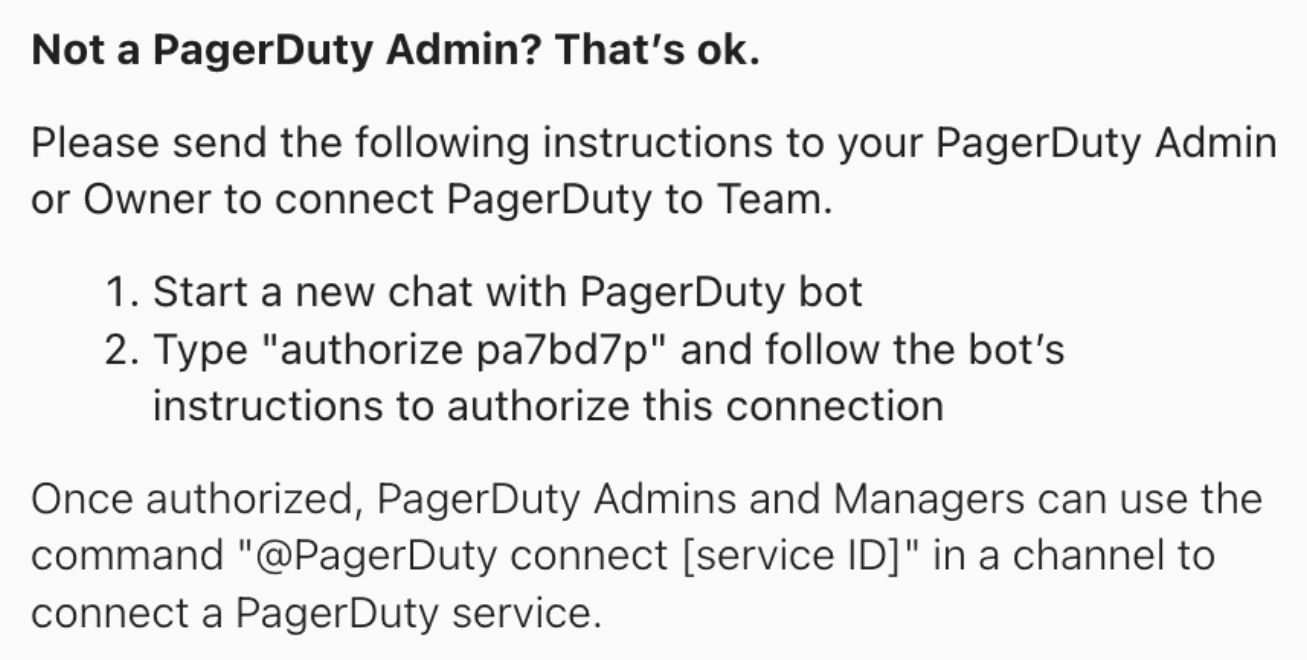
App Authorization Instructions for PagerDuty Admin
-
-
After your PagerDuty Admin clicks Authorize, a PagerDuty login page will open in a separate window. Log in with PagerDuty Admin or Account Owner credentials to connect PagerDuty to the team you selected.
Note: If you are already logged into PagerDuty, this step will be bypassed.
You will be directed to the Microsoft Teams Integration page in your PagerDuty account and you should see a success message:
"You've successfully connected the[YOUR TEAM NAME]team to PagerDuty".
If you receive the following error messages:- "We can't connect Microsoft Teams to PagerDuty. Authorization cannot be completed at this time. You may close this window."
- "We can't connect Microsoft Teams to PagerDuty. The authorization link has expired or is not valid. Return to Teams to generate a new one. You may close this window."
Your PagerDuty user account may not have the correct permissions to complete the setup, or the connection link has expired. Ensure that your PagerDuty role is an Account Owner or Global Admin, check to see if another private chat with the PagerDuty bot has been sent with a renewed link, and retry authorizing the connection from Microsoft Teams.
-
For the final phase of setup, you will receive a message from the PagerDuty app to complete setup by authorizing PagerDuty to the Microsoft Graph API.
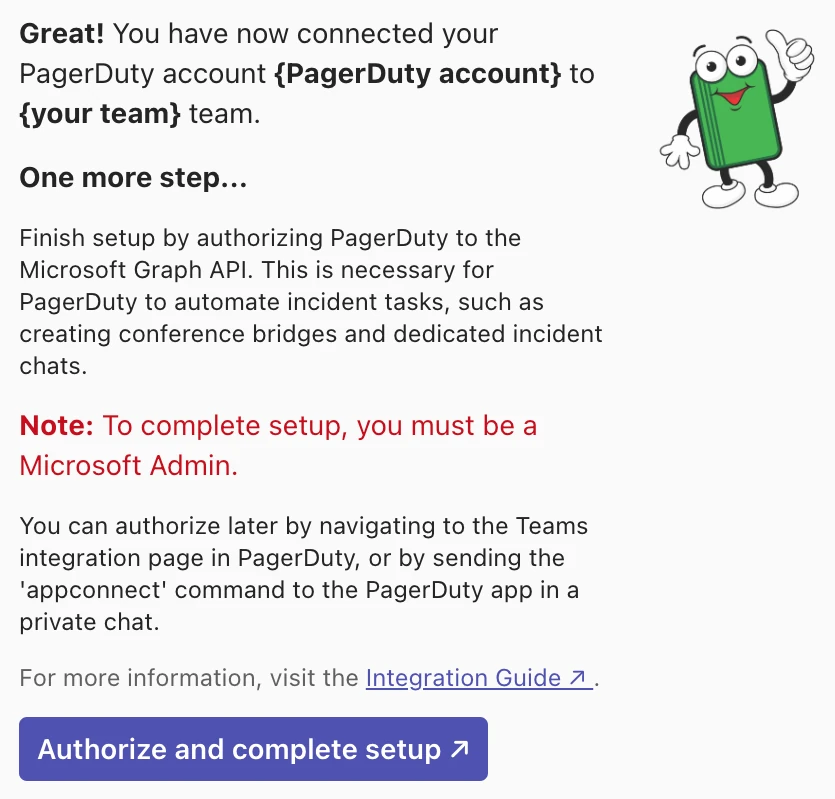
Microsoft Graph API authorization prompt
-
If you are a Microsoft Admin: Click Authorize and complete setup.
-
If you are not a Microsoft Admin:
- Ask your Microsoft admin to message the PagerDuty app with the command
appconnectto complete this step - Or ask them to visit the PagerDuty web app, navigate to Integrations → Microsoft Teams Integration, and click
Authorize
- Ask your Microsoft admin to message the PagerDuty app with the command
-
After clicking Authorize and complete setup, a Microsoft permissions prompt will open in a separate window. Click Accept.
Note: For a full list of the permissions being requested and their purpose, please see the FAQ: What Microsoft Graph permissions are required by the PagerDuty app?
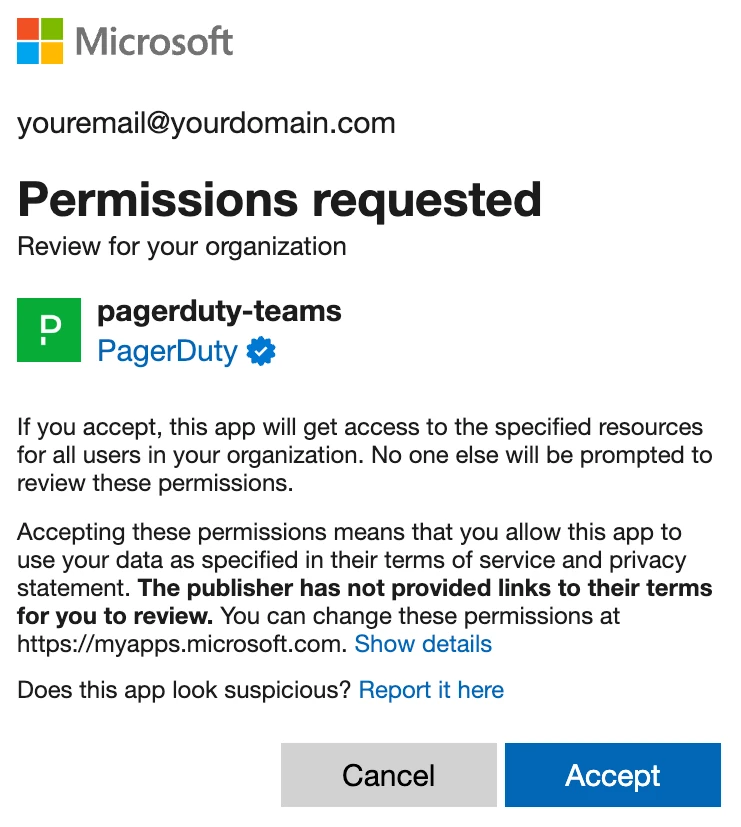
Microsoft Graph API permissions consent screen
-
Setup is now complete!
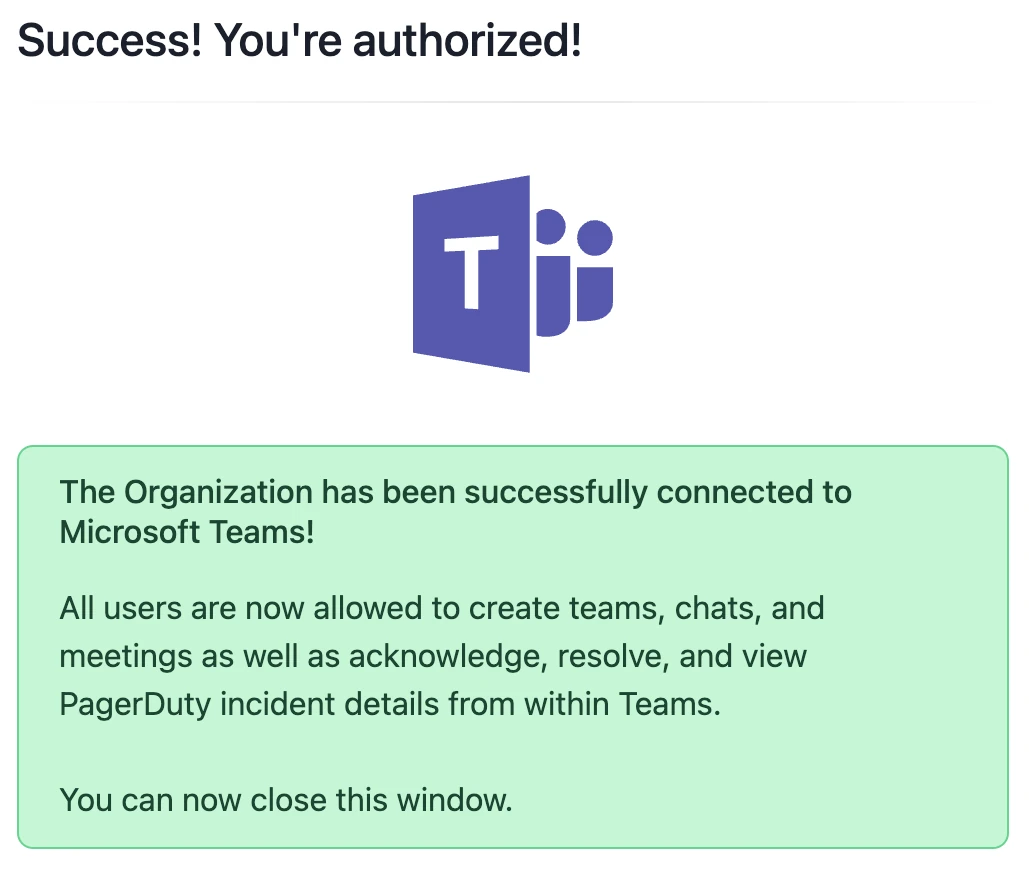
Authorization successful
To connect additional teams to the same PagerDuty account
-
You can repeat step 1 of this section from within Microsoft Teams.
Alternatively, a PagerDuty Admin can visit the PagerDuty web app, navigate to Integrations → Microsoft Teams Integration, and click + Connect More Teams.

Connect More Teams button on the Microsoft Teams integration page in PagerDuty
-
From there, follow steps 2 to 5, and repeat this process for each additional team you would like to connect to PagerDuty.
To enable PagerDuty to create Microsoft Teams meetings
During setup, your Microsoft admin granted PagerDuty access to the Microsoft Graph API. One of the permissions we request is for the ability to create calendar events. This allows our application to create a calendar event and attach a Microsoft Teams meeting, which will be used as the PagerDuty incident’s conference bridge.
The permission to create calendar events is optional. If you need to revoke this permission, your Microsoft admin must configure an access policy to allow applications to create new Teams meetings on behalf of users. Please see the official Microsoft documentation for instructions, or have your Microsoft admin run the following Powershell command:
Note: PAGERDUTY_ACCESS_POLICY below is a placeholder policy name, and can be modified.
Install-Module -Name PowerShellGet -Force -AllowClobber
Install-Module -Name MicrosoftTeams -Force -AllowClobber
Import-Module MicrosoftTeams
$credential = Get-Credential
Connect-MicrosoftTeams -Credential $credential
New-CsApplicationAccessPolicy -Identity "PAGERDUTY_ACCESS_POLICY" -AppIds "05ffe668-5b27-45ff-a64d-b2ed6c475d7a" -Description "Policy for enabling online meetings with application token for PagerDuty"
Grant-CsApplicationAccessPolicy -PolicyName "PAGERDUTY_ACCESS_POLICY" -Global
Or the following command for customers in the EU:
Install-Module -Name PowerShellGet -Force -AllowClobber
Install-Module -Name MicrosoftTeams -Force -AllowClobber
Import-Module MicrosoftTeams
$credential = Get-Credential
Connect-MicrosoftTeams -Credential $credential
New-CsApplicationAccessPolicy -Identity "PAGERDUTY_ACCESS_POLICY" -AppIds "8f79a561-d2f1-4a1e-8092-c2039043a40e" -Description "Policy for enabling online meetings with application token for PagerDuty"
Grant-CsApplicationAccessPolicy -PolicyName "PAGERDUTY_ACCESS_POLICY" -Global
Link PagerDuty Services to Microsoft Teams Channels
After you connect PagerDuty to your team, you can begin linking PageDuty services to your team's channels. You can link a channel to one or many PagerDuty services.
Required User Permissions
PagerDuty Admins can configure service-channel mappings through the PagerDuty web app or the PagerDuty app in Microsoft Teams.
PagerDuty Managers can configure service-channel mappings through the PagerDuty app in Microsoft Teams only.
- PagerDuty Managers (base role) can link any PagerDuty service to Microsoft Team channels.
- PagerDuty Managers (team role) can link their PagerDuty team’s services to Microsoft Team channels.
Using the PagerDuty Web App
- In the PagerDuty web app, navigate to Integrations → Microsoft Teams Integration.
- Expand the team that you have connected to PagerDuty, and click + Connect Notification Channel.
- Select which PagerDuty service and which Microsoft Teams channel that you would like to connect to each other from the dropdown lists.
- Click Connect to complete the service-channel connection.
- Repeat these steps to connect additional services and channels.
Using the PagerDuty app in Microsoft Teams
- In Microsoft Teams, under the team you have connected to PagerDuty, select the channel that you would like to connect to a PagerDuty service.
- Click Start a post.
- Enter the following app command, ensuring the PagerDuty bot is mentioned in the message:
@PagerDuty connect [link to the service URL in PagerDuty] - Click Connect Service.
- Repeat these steps to connect additional services and channels.
Once the PagerDuty service is connected to a team’s channel, incident notifications will be visible to all members in the channel.
Link PagerDuty and Microsoft Teams User Accounts
Responders must link their PagerDuty and Microsoft Teams user accounts to perform incident actions in Microsoft Teams. Also, responders with linked user accounts are automatically added to the Microsoft Teams meeting and/or chat, when a meeting and/or chat is created for the incident.
- To receive a personal account mapping link, users can follow the below options:
- Click Link Accounts on the welcome message posted by the PagerDuty bot in the General channel, upon successfully connecting its team to PagerDuty;
- Click Link Accounts on the welcome message posted by the PagerDuty bot in a channel, upon successfully connecting the channel to a PagerDuty service; or
- In a private chat message with the PagerDuty bot, enter
linkUser
You will receive a private chat message from the PagerDuty bot, containing your personal user account mapping button.
- From the PagerDuty bot's private chat message, click Link Accounts.
- A PagerDuty login page will open in a separate window. Log in with your PagerDuty credentials to link your PagerDuty and Microsoft Teams user accounts.
Note: If you have already logged in, this step will be bypassed.
You will be directed to the Microsoft Teams Integration page in your PagerDuty account and you should see a success message:You've successfully linked your user accounts.
All PagerDuty actions you perform as
[MS-TEAMS-NAME]in Microsoft Teams will be associated with[PAGERDUTY-NAME](PAGERDUTY-EMAIL) in PagerDuty.If you this is not correct, please enter the
@PagerDuty unlinkUsercommand in Microsoft Teams to unlink your account.
If you receive an error, verify that the PagerDuty credentials are correct and the user account is provisioned in the correct PagerDuty account. To find which PagerDuty account is connected to Microsoft Teams, enter the app command@PagerDuty openin any channel. Your organization’s PagerDuty account will open in a new browser window, and you can see your account’s subdomain in the address bar (e.g.subdomain.pagerduty.com).
Microsoft Teams User Guide
Once initial configuration is complete, please read our Microsoft Teams User Guide for instructions on how to use the integration.
Upgrade PagerDuty's Microsoft Teams Application
To use the features in the latest Microsoft Teams integration, customers using the legacy Microsoft Teams connector application will need to upgrade.
Microsoft no longer supports the legacy Microsoft Teams application. If you have been using the legacy Microsoft Teams application and you would like to upgrade to our current one, you must first remove the legacy connectors.
- In your Microsoft Teams console, search for and select the Pagerduty (Legacy) app.
- Click Add to a Team, and then select the team that is using the legacy connectors.
- Once a team has been selected, click Set up Connector, which will take you to the connectors page. In the left menu, navigate to Manage Configured.
- Click the Manage button next to the connector. The remove option is located towards the bottom of the page.
- After you have removed all the connectors, you will need to remove the app from the team. Navigate to Teams click the ellipsis to the right of your team's name Manage team Apps tab click the to the right of the PagerDuty (Legacy) app.
- Repeat the above steps for each team that uses connectors.
Microsoft Teams User Guide
Please read our Microsoft Teams User Guide for more information about using the integration after it has been configured.
FAQ
Why do I see an UPDATE AVAILABLE message next to my Microsoft Teams tenant ID?
This message indicates that PagerDuty is requesting permissions to the Microsoft Graph API that you have not yet authorized. This authorization is required for PagerDuty to automate incident tasks, such as creating Teams meetings and dedicated chats for an incident.
Please have your Microsoft Admin authorize this tenant to enable all features of our PagerDuty Teams application.
Note: Some of our requested permissions are optional. For a full list of our permissions and their purpose, please see the FAQ: What Microsoft Graph permissions are required by the PagerDuty app?. Additionally, you may visit our Microsoft Permissions Changelog to view a log of what has changed recently.

Update Available
What Microsoft Graph permissions are required by the PagerDuty app?
Permissions Changelog
For specific information on changes to our Microsoft Teams application permissions, please see the Microsoft Teams Permission Changelog.
Ongoing changes to our Teams permission model
Historically, PagerDuty would automate incident tasks in Teams by requesting user-level (AKA delegated) permissions from individual users.
We have transitioned to use application-level permissions, granted by your Microsoft Teams admin.
These application permissions are all "Least Privileged Permissions," i.e., we only request the minimum permissions necessary to support the features of the PagerDuty application.
As of September 1st, 2024 we no longer use the Delegated permissions, which are displayed in the table below. We may still be requesting these delegated permissions as we complete our transition, and you may revoke these permissions until they are entirely removed.
PagerDuty Cloud Operations and Incident Management functionality in Microsoft Teams requires access to the following scopes.
The Description field is what is displayed on the Microsoft Permissions Consent screen that you are presented when first installing and configuring the PagerDuty Teams app.
Required Permissions
| Purpose | Description | Permission | Type | Least Privileged Permission |
|---|---|---|---|---|
| Creating a new dedicated chat for an incident | Create chats | Chat.Create | Application | ✅ |
| Adding incident responders to dedicated incident chats | Add and remove members from all chats | ChatMember.ReadWrite.All | Application | ✅ |
| Creating an online meeting | Read and create online meetings | OnlineMeetings.ReadWrite.All | Application | ✅ |
| Fetching the name of the Teams organization, so it can be displayed and selected in PagerDuty workflow configuration screens | Read organization information | Organization.Read.All | Application | ✅ |
| Adding the PagerDuty app to a dedicated incident chat for sending incident messages | Manage Teams apps for all chats | TeamsAppInstallation.ReadWriteSelfForChat | Application | ✅ |
| Automatically adding responders to Teams meetings and chats without requiring their accounts to be linked. (1) | Read all users' full profiles | User.Read.All Note: PagerDuty is in the process of removing this permission, see the changelog for more information. | Application | ❌ |
| Automatically adding responders to Teams meetings and chats without requiring their accounts to be linked. | Read all users' basic profiles | User.ReadBasic.All | Application | ✅ |
| Creating a new dedicated chat for an incident | Read and write user chat messages | Chat.ReadWrite | Delegated | ❌ |
| Ability to refresh tokens to ensure features continue working | Maintain access to data you have given it access to | offline_access | Delegated | ✅ |
| Creating an online meeting | Read and create user's online meetings | OnlineMeetings.ReadWrite | Delegated | ✅ |
| Adding the PagerDuty app to a dedicated incident chat for sending incident card messages | Manage installed Teams apps in chats | TeamsAppInstallation.ReadWriteForChat | Delegated | ❌ |
| Fetching the name of the Teams organization, so it can be displayed and selected in PagerDuty workflow configuration screens | Sign in and read user profile | User.Read | Delegated | ✅ |
| Automatically adding responders to Teams meetings and chats without requiring their accounts to be linked. | Read all users' basic profiles | User.ReadBasic.All | Delegated | ✅ |
| Adding claim information about the user when making requests | openid, email, profile | Delegated | ✅ |
(1) We request a limited set of information from the Microsoft Graph API when using this scope: id, mail and userPrincipalName.
Optional Permissions
The PagerDuty app for Microsoft Teams requests some permissions which are optional, depending on how customers would like our application to function. These optional permissions can be revoked following installation of our application.
| Purpose | Description | Permission | Type | Least Privileged Permission |
|---|---|---|---|---|
| Create an online meeting | Read and write calendars in all mailboxes. If revoked, customers must perform manual configuration to enable PagerDuty to create meetings. | Calendars.ReadWrite | Application | ✅ |
Optional Permissions for PagerDuty Advance
PagerDuty Advance is a set of assistive automation capabilities for the PagerDuty Operations Cloud. To enable the use of PagerDuty Advance in Microsoft Teams, we request additional optional permissions for our Microsoft Teams application. These permissions are optional, and can be revoked following installation of our application, if you do not wish to leverage PagerDuty Advance features.
| Purpose | Description | Permission | Type | Least Privileged Permission |
|---|---|---|---|---|
| Fetching chat messages from conversations to use in Advance features (e.g. incident wrap up, status update generation, etc). | Allows the app to read all one-to-one and group chats messages in Microsoft Teams | ChatMessage.Read.All | Application | ✅ |
Why don't I see a PagerDuty app installation confirmation message for my team?
The PagerDuty app's presence on this team may prevent you from receiving this private chat message from the PagerDuty bot. You will need to remove the app from the team first.
Your Microsoft team's Admin can remove the PagerDuty app from the team, by following this step in Microsoft Teams:
- Navigate to Teams click the ellipsis to the right of your team's name Manage team Apps tab. Click the ellipsis to the right of the PagerDuty app and click Remove to remove the app from the team.
From there, repeat step 2 under the Connect PagerDuty to a Microsoft Team section, to add the PagerDuty app to this team.
How do I remove the PagerDuty service from my team channel connection?
A PagerDuty Admin or Account Owner can remove a service to channel connection via PagerDuty’s Microsoft Teams extension page.
- Navigate to Integrations Extensions Microsoft Teams Integration tile.
- Next, click next to Notification Channels Remove next to the service-channel connection you’d like to disconnect.

Remove connection
- In the confirmation dialog, click Remove.
How do I disconnect the PagerDuty app from a team?
A PagerDuty Admin or Account Owner can disconnect the app in PagerDuty on the Microsoft Teams extension's page. Disconnecting or un-authorizing a team removes the link between Microsoft Teams and PagerDuty. By disconnecting, all channel to service connections will be deleted and user account mappings will be removed.
- Navigate to Integrations Extensions Microsoft Teams Integration tile.
- Click Disconnect next to the team name.
- Enter
disconnectin the text field. - Click I understand my actions. Remove PagerDuty from this Microsoft Team. to complete the disconnection.
- In Microsoft Teams, navigate to Teams click the ellipsis to the right of your team's name Manage team Apps tab. Click the ellipsis to the right of the PagerDuty app and click Remove to remove the app from the team.
If you choose to reauthorize an application, users will need to reinstall the application into a team.
How are Microsoft Teams users able to take action on messages from the PagerDuty bot?
We utilize user mapping between a PagerDuty user and their associated Microsoft Teams user. This is done via OAuth Tokens. These tokens are used to communicate with PagerDuty’s REST API.
Can a single Microsoft Teams environment connect to multiple different PagerDuty accounts?
Yes, that is correct.
What information is stored?
After adding the PagerDuty bot to a team, the bot has access to:
- Channels in the team.
After adding the PagerDuty bot to a channel or chat, it can:
- Read the members’ information of the channel, chat, or conversation where it was added.
- Send messages.
- Reply in conversation.
- Update messages sent to it.
- Read messages where it was mentioned.
- Get an event when a team or channel is renamed.
- Get an event when a new user is added.
- Show popups.
The bot cannot:
- Read any message it wasn't mentioned in.
- Be added to private channels.
As we use Microsoft Graph API, some confirmation will be requested during the installation/authorization process.
It requests such scopes as:
user.readbasic.allonlinemeetings.readwriteoffline_access
Please read Microsoft's documentation for more information about scopes.
Updated 6 months ago
